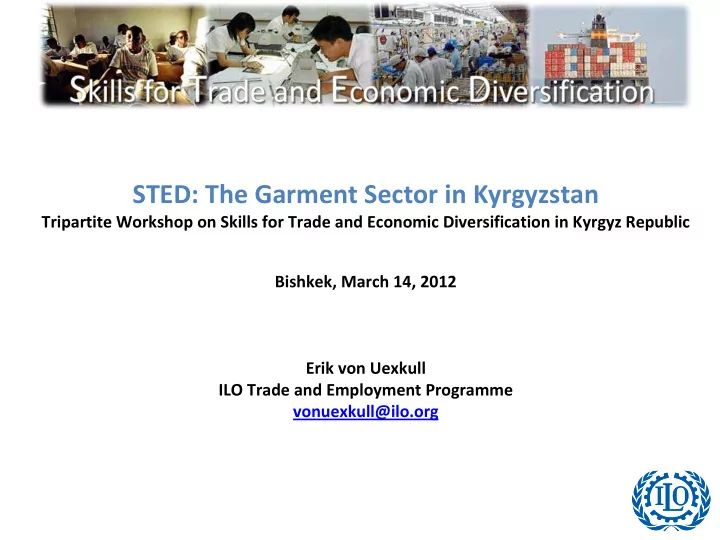

STED: The Garment Sector in Kyrgyzstan Tripartite Workshop on Skills for Trade and Economic Diversification in Kyrgyz Republic Bishkek, March 14, 2012 Erik von Uexkull ILO Trade and Employment Programme vonuexkull@ilo.org
WHAT IS STED? • Methodology that provides strategic guidance for the integration of skills development in sectoral policies. • Designed to support growth and decent employment creation in sectors that have the potential to increase exports and to contribute to economic diversification. • An ANALYTICAL exercise, but can be a starting point for targeted technical assistance
WHY STED?
Exporters have higher skill needs Source: World Bank Enterprise Survey 2009
Skills contribute to Export Diversification Source: Cadot et al. (2011). Panel Regression Results on 87 countries, 1990-2004.
But ‘getting skills right’ is not easy • High unemployment among well educated • At the same time, firms struggle to find the qualified personnel ( skills mismatch) • trade can lead to rapid changes and adjustment STED helps policy makers to ensure that firms find workers with the right skills and workers acquire the skills needed to find productive employment.
STED Methodology
SOME PRELIMINARY FINDINGS
Sector Characteristics • Export (and import) oriented, strong growth • High concentration on low ‐ income markets in Russia and Kazakhstan through traditional distribution channels • Low labour productivity, competitiveness based on cheap labour • High levels of informality and semi ‐ formality
External Factors • Patent System • Customs Union with Russia, Kazakhstan, Belarus Tariffs on intermediate inputs Non Tariff Barriers • Russia’s WTO Accession
Effect of CU on Import Tariffs Source: ITC Market Access Map
Preference Erosion in Russian Market Source: ITC Market Access Map and Russia’s WTO accession documents
Sector Position and Outlook • Strong growth, but increasing competitive pressure in current markets • Current model of competitiveness has reached its limits Increase Labour Productivity Develop new markets / products / distribution channels Structural change / consolidation → Focus on labour demand / skill needs of “pioneer” firms
Skill Gaps (Survey Results) • Most difficult to find: dyers designers gaugers cutters • Increasing demand expected for: cutters designers universal sewers process engineers
Skill Supply • Respondents reluctant to hire graduates of existing education system • High levels of on the job training for low skilled activities • Labour migration to Russia and Kazakhstan
Training Needs • Survey Responses: Sewers Designers Marketing, procurement and sales personnel Cutters Gaugers Machine operators Packaging workers Administrators • Report also recommends training / consulting for top management on topics like product and market development, value chain integration
Policy Recommendations • ‘Go it alone’ or institutional reform? • Report favours institutional approach: Interest of all stakeholders in strengthening education and training systems Strong position of the sector to drive reform Progress already made
Institutional Recommendations • Report makes detailed recommendations in the following areas of educational institution reform: new and revised curricula Strengthening cooperation between industry and education institutions, Training and certification of teachers Technical equipment of training institutions
Enterprise Recommendations • Firms in the sector have an important role to play in skills upgrading and improvement • Promote a more sustainable culture of employment where employers and workers have an incentive to invest in training and skills Reduce labour turnover Enhance social dialogue and workplace cooperation Stop exodus of skilled workers
Recommend
More recommend